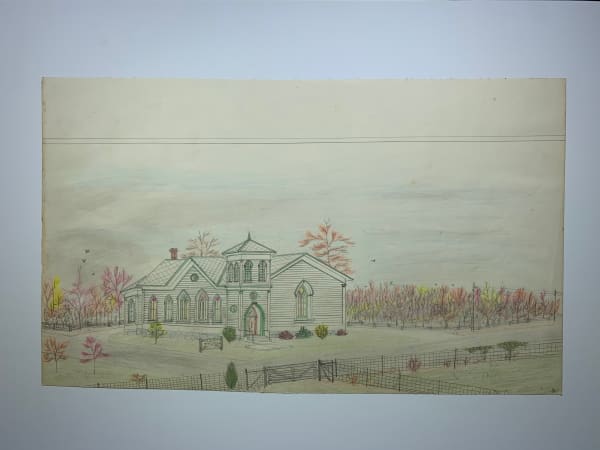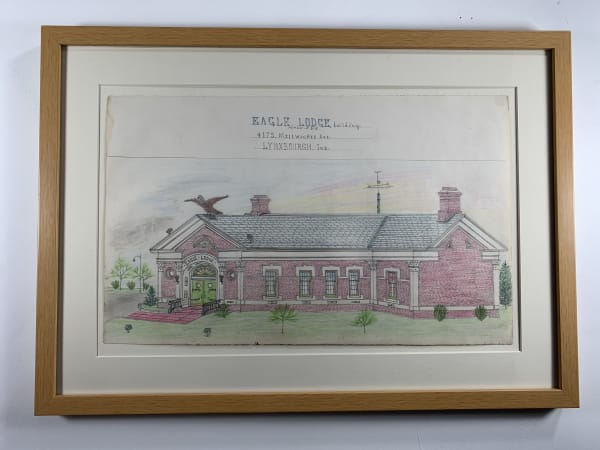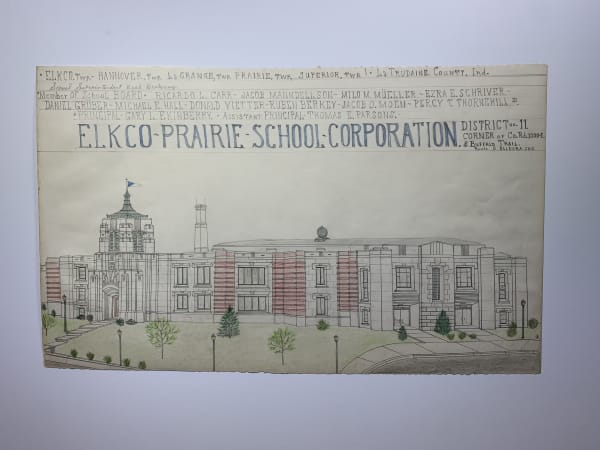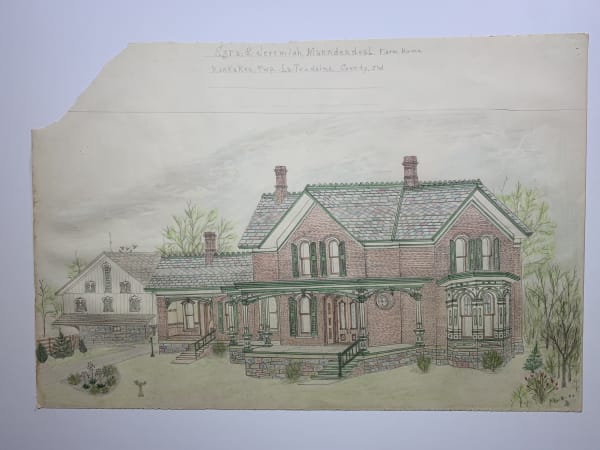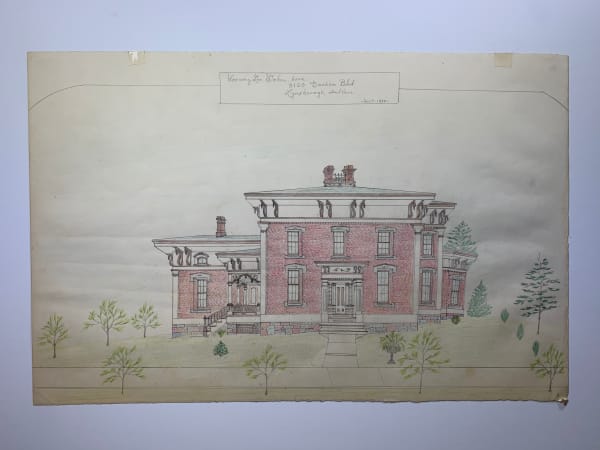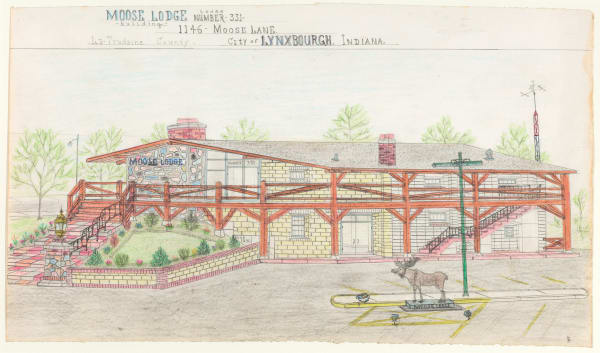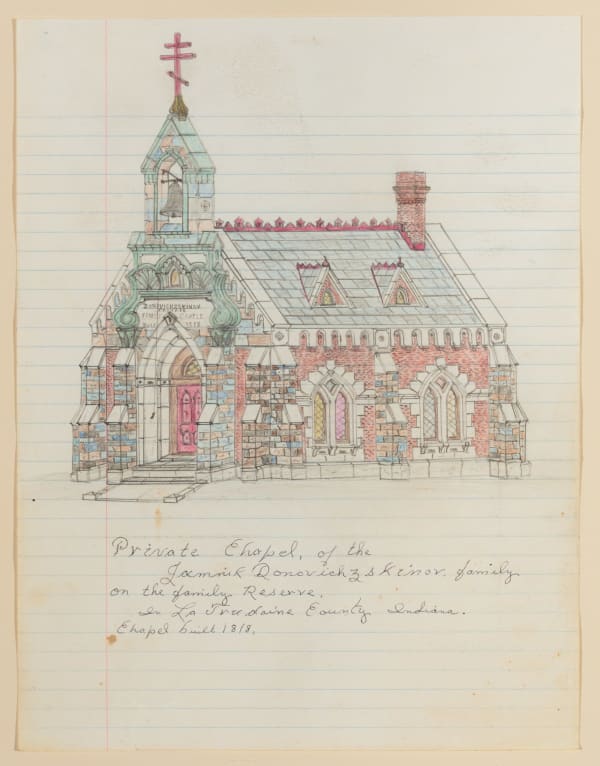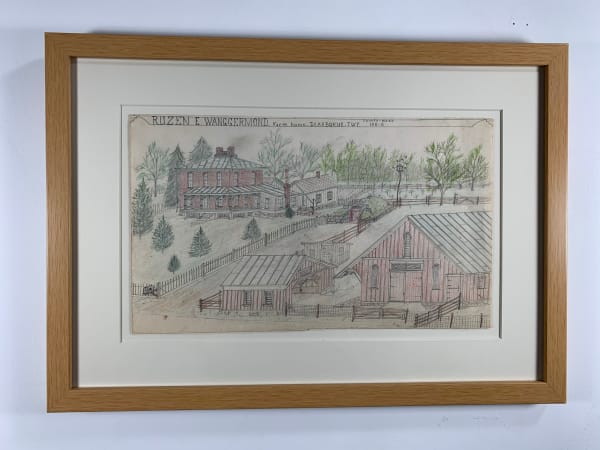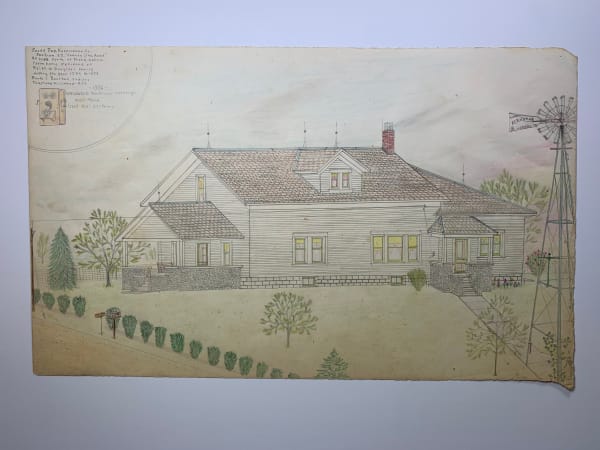Jacques De Du-Glass 1898-1993
Siting it within the state of Indiana, in a series of finely drafted, meticulous, and imaginative drawings Jàcques de Dû-Glass created an imaginary town called Lynxbourgh, which he filled with architectural illustrations and landscapes that blur the line between reality and fiction. Dû-Glass was born James Donald Beatty to a single mother who gave him up for adoption. He was raised by the Douglass family on their farm in the outskirts of Warsaw, Indiana (in Kosciusko County), and did not receive a formal education. As a middle-aged man, after reportedly finding that “Douglass” had French origins, he changed his name to Dû-Glass, creating an alter ego befitting the self-taught artist demiurge, the creator of the parallel reality in his work.
Lynxbourgh is not, however, a site of fantastical events or otherworldly creatures, but resembles and incorporates the environment in which Dû-Glass lived: many buildings illustrated have real counterparts, and there are churches and temples, boulevards, lavish suburban homes with tidy gardens, libraries with American flags, fraternal lodges, homesteads, YMCAs, schools, and metropolitan features. Dû-Glass was particularly interested in the visual motif of architecture and in the history of specific buildings in Indiana, but through his subtle tinkering with reality and denotation, as Joseph Yoakum did with his sprawling, imaginary landscapes (p. 247), Dû-Glass found a way to reaffirm his agency and express his ideals. Lynxbourgh strikes the viewer as a Platonic notion, a highly developed place existing only in the mind’s eye but made fully visible on paper.
In his lifetime, Dû-Glass saw only sporadic success, and his career as an artist was fruitless. He was discharged from many jobs and his insecurity about his sexuality caused his marriage to fail. As is the case of so many self-taught artists, Dû-Glass’s work went on to receive posthumous recognition; exhibitions of his art have been held at Carl Hammer Gallery (Chicago), Lindsay Gallery (Columbus, Ohio), and the Outsider Art Fair (New York), and his work was included in the group exhibition Farfetched: Mad Science, Fringe Architecture and Visionary Engineering, curated by Tom Patterson and Roger Manley at the Gregg Museum of Art and Design in Raleigh, North Carolina, in 2013.
-
 Saint Stephen Parish School Lynxbourgh, Indiana, c. 1992
Saint Stephen Parish School Lynxbourgh, Indiana, c. 1992 -
 American Legion Post and Elks Lodge Lynxbourgh, Indiana, c. 1992
American Legion Post and Elks Lodge Lynxbourgh, Indiana, c. 1992 -
 Brethren Church Lynxbourgh, Indiana, c. 1992
Brethren Church Lynxbourgh, Indiana, c. 1992 -
 Bungalows of the 1930sOland Syler HomeGerrard E. LutesLynxbourgh, Indiana, c. 1992
Bungalows of the 1930sOland Syler HomeGerrard E. LutesLynxbourgh, Indiana, c. 1992 -
 Cathedral BLVDNon-Congregational churchLynxbourgh, Indiana, c. 1992
Cathedral BLVDNon-Congregational churchLynxbourgh, Indiana, c. 1992 -
 Cathedral of the Holy Angel DivineLynxbourgh, Indiana, c. 1992
Cathedral of the Holy Angel DivineLynxbourgh, Indiana, c. 1992 -
 Chamber of CommerceLynxbourgh, Indiana, c. 1992
Chamber of CommerceLynxbourgh, Indiana, c. 1992 -
 Douglas H. Tyson City HomeLynxbourgh, Indiana, c. 1992
Douglas H. Tyson City HomeLynxbourgh, Indiana, c. 1992 -
 Du-Glass HallLynxbourgh, Indiana, c. 1992
Du-Glass HallLynxbourgh, Indiana, c. 1992 -
 Eagle LodgeLynxbourgh, Indiana, c. 1992
Eagle LodgeLynxbourgh, Indiana, c. 1992 -
 Ebenezer Corners Church of the BrethrenLynxbourgh, Indiana, c. 1992
Ebenezer Corners Church of the BrethrenLynxbourgh, Indiana, c. 1992 -
 Elkco Prairie School CorporationLynxbourgh, Indiana, c. 1992
Elkco Prairie School CorporationLynxbourgh, Indiana, c. 1992 -
 Ezra and Jeremiah Manndendoal Farm HomeLynxbourgh, Indiana, c. 1992
Ezra and Jeremiah Manndendoal Farm HomeLynxbourgh, Indiana, c. 1992 -
 Free Methodist ChurchOtterbein ChurchLynxbourgh, Indiana, c. 1992
Free Methodist ChurchOtterbein ChurchLynxbourgh, Indiana, c. 1992 -
 German Baptist BrethrenLynxbourgh, Indiana, c. 1992
German Baptist BrethrenLynxbourgh, Indiana, c. 1992 -
 Gethsemani Garden TabernacleLynxbourgh, Indiana, c. 1992
Gethsemani Garden TabernacleLynxbourgh, Indiana, c. 1992 -
 Good Will IndustriesLynxbourgh, Indiana, c. 1992
Good Will IndustriesLynxbourgh, Indiana, c. 1992 -
 Harold & Peggy Harter Home Lynxbourgh, Indiana, c. 1992
Harold & Peggy Harter Home Lynxbourgh, Indiana, c. 1992 -
 Harter & Chloe Cooke Family Farm Home Lynxbourgh, Indiana, c. 1992
Harter & Chloe Cooke Family Farm Home Lynxbourgh, Indiana, c. 1992 -
 Harvey Lee Gohen Home Lynxbourgh, Indiana, c. 1992
Harvey Lee Gohen Home Lynxbourgh, Indiana, c. 1992 -
 Hiram & Etta Briggs Family Homestead Lynxbourgh, Indiana, c. 1992
Hiram & Etta Briggs Family Homestead Lynxbourgh, Indiana, c. 1992 -
 Hobert C. Evanson Lynxbourgh, Indiana, c. 1992
Hobert C. Evanson Lynxbourgh, Indiana, c. 1992 -
 Home of Albert & Rhoda Vanderdorne Lynxbourgh, Indiana, c. 1992
Home of Albert & Rhoda Vanderdorne Lynxbourgh, Indiana, c. 1992 -
 Home of Ivan J. Welty Lynxbourgh, Indiana, c. 1992
Home of Ivan J. Welty Lynxbourgh, Indiana, c. 1992 -
 Home of Seth Stockhome Lynxbourgh, Indiana, c. 1992
Home of Seth Stockhome Lynxbourgh, Indiana, c. 1992 -
 Jacob & Melinda Flory Home Lynxbourgh, Indiana, c. 1992
Jacob & Melinda Flory Home Lynxbourgh, Indiana, c. 1992 -
 Karo School Lynxbourgh, Indiana, c. 1992
Karo School Lynxbourgh, Indiana, c. 1992 -
 Knights of Columbus Lodge Lynxbourgh, Indiana, c. 1992
Knights of Columbus Lodge Lynxbourgh, Indiana, c. 1992 -
 La Grange Center Community Grade School Lynxbourgh, Indiana, c. 1992
La Grange Center Community Grade School Lynxbourgh, Indiana, c. 1992 -
 La Trudaine R. E. M. C. Building Lynxbourgh, Indiana, c. 1992
La Trudaine R. E. M. C. Building Lynxbourgh, Indiana, c. 1992 -
 Lion's Club Building, Shriner's Building Lynxbourgh, Indiana, c. 1992
Lion's Club Building, Shriner's Building Lynxbourgh, Indiana, c. 1992 -
 Lynxborough City Coliseum Lynxbourgh, Indiana, c. 1992
Lynxborough City Coliseum Lynxbourgh, Indiana, c. 1992 -
 Lynxbourgh City Library Lynxbourgh, Indiana, c. 1992
Lynxbourgh City Library Lynxbourgh, Indiana, c. 1992 -
 Lynxbourgh City Police Station Lynxbourgh, Indiana, c. 1992
Lynxbourgh City Police Station Lynxbourgh, Indiana, c. 1992 -
 Main Post Office Lynxborough Area Lynxbourgh, Indiana, c. 1992
Main Post Office Lynxborough Area Lynxbourgh, Indiana, c. 1992 -
 Masonic Lodge Temple Building Lynxbourgh, Indiana, c. 1992
Masonic Lodge Temple Building Lynxbourgh, Indiana, c. 1992 -
 Melvin E. Stockhem Home Lynxbourgh, Indiana, c. 1992
Melvin E. Stockhem Home Lynxbourgh, Indiana, c. 1992 -
 Middleton School Corporation Lynxbourgh, Indiana, c. 1992
Middleton School Corporation Lynxbourgh, Indiana, c. 1992 -
 Moose Lodge Lynxbourgh, Indiana, c. 1992
Moose Lodge Lynxbourgh, Indiana, c. 1992 -
 Old Russian Orthodox Chapel & Cathedral Lynxbourgh, Indiana, c. 1992
Old Russian Orthodox Chapel & Cathedral Lynxbourgh, Indiana, c. 1992 -
 Old Town Inn & Pub Lynxbourgh, Indiana, c. 1992
Old Town Inn & Pub Lynxbourgh, Indiana, c. 1992 -
 Private Chapel of the Donovich Z. Skinor Family Lynxbourgh, Indiana, c. 1992
Private Chapel of the Donovich Z. Skinor Family Lynxbourgh, Indiana, c. 1992 -
 Private Residence of Ivan V. Dominickovich Lynxbourgh, Indiana, c. 1992
Private Residence of Ivan V. Dominickovich Lynxbourgh, Indiana, c. 1992 -
 Private Residence of Tobias BriggsLynxbourgh, Indiana, c. 1992
Private Residence of Tobias BriggsLynxbourgh, Indiana, c. 1992 -
 Residence of Dr. Morris Lynxbourgh, Indiana, c. 1992
Residence of Dr. Morris Lynxbourgh, Indiana, c. 1992 -
 River Valley Senior High School Lynxbourgh, Indiana, c. 1992
River Valley Senior High School Lynxbourgh, Indiana, c. 1992 -
 Rowelyndolffe Building Lynxbourgh, Indiana, c. 1992
Rowelyndolffe Building Lynxbourgh, Indiana, c. 1992 -
 Ruzen E. Wanggermond Farm Home Lynxbourgh, Indiana, c. 1992
Ruzen E. Wanggermond Farm Home Lynxbourgh, Indiana, c. 1992 -
 Saint Angelo Greek Orthodox Church Lynxbourgh, Indiana, c. 1992
Saint Angelo Greek Orthodox Church Lynxbourgh, Indiana, c. 1992 -
 Saint Dionovsius Parish Rectory Lynxbourgh, Indiana, c. 1992
Saint Dionovsius Parish Rectory Lynxbourgh, Indiana, c. 1992 -
 Saint Louis Roman Catholic Church Lynxbourgh, Indiana, c. 1992
Saint Louis Roman Catholic Church Lynxbourgh, Indiana, c. 1992 -
 Saint Mary's Catholic Church Lynxbourgh, Indiana, c. 1992
Saint Mary's Catholic Church Lynxbourgh, Indiana, c. 1992 -
 Sainte Pierre Catholic Cathedral Lynxbourgh, Indiana, c. 1992
Sainte Pierre Catholic Cathedral Lynxbourgh, Indiana, c. 1992 -
 Scott Millwood Millwood Telephone Exchange, Lynxbourgh, Indiana, c. 1992
Scott Millwood Millwood Telephone Exchange, Lynxbourgh, Indiana, c. 1992 -
 Simon D. Wattsworth Home Lynxbourgh, Indiana, c. 1992
Simon D. Wattsworth Home Lynxbourgh, Indiana, c. 1992 -
 Spear Mint Distill Lynxbourgh, Indiana, c. 1992
Spear Mint Distill Lynxbourgh, Indiana, c. 1992 -
 St. Luke's Episcopal Church Lynxbourgh, Indiana, c. 1992
St. Luke's Episcopal Church Lynxbourgh, Indiana, c. 1992 -
 Stoney Creek School Corporation Lynxbourgh, Indiana, c. 1992
Stoney Creek School Corporation Lynxbourgh, Indiana, c. 1992 -
 Stony Point Church Lynxbourgh, Indiana, c. 1992
Stony Point Church Lynxbourgh, Indiana, c. 1992 -
 Superior Court Building Lynxbourgh, Indiana, c. 1992
Superior Court Building Lynxbourgh, Indiana, c. 1992 -
 Swiss Valley Chapel Lynxbourgh, Indiana, c. 1992
Swiss Valley Chapel Lynxbourgh, Indiana, c. 1992 -
 Swiss Valley School Corporation Lynxbourgh, Indiana, c. 1992
Swiss Valley School Corporation Lynxbourgh, Indiana, c. 1992 -
 The Church of God Lynxbourgh, Indiana, c. 1992
The Church of God Lynxbourgh, Indiana, c. 1992 -
 The Metropolis City Skyline Lynxbourgh, Indiana, c. 1992
The Metropolis City Skyline Lynxbourgh, Indiana, c. 1992 -
 The Old Family Homestead of Historic Manor Lynxbourgh, Indiana, c. 1992
The Old Family Homestead of Historic Manor Lynxbourgh, Indiana, c. 1992 -
 The Pennsylvaniaian Lynxbourgh, Indiana, c. 1992
The Pennsylvaniaian Lynxbourgh, Indiana, c. 1992 -
 The Unitarian Church Lynxbourgh, Indiana, c. 1992
The Unitarian Church Lynxbourgh, Indiana, c. 1992 -
 Turkey Runn School Corporation Lynxbourgh, Indiana, c. 1992
Turkey Runn School Corporation Lynxbourgh, Indiana, c. 1992 -
 United Pentecostal Church Lynxbourgh Wesleyan Church United Missionary Church Quaker Friends Meeting House Lynxbourgh, Indiana, c. 1992
United Pentecostal Church Lynxbourgh Wesleyan Church United Missionary Church Quaker Friends Meeting House Lynxbourgh, Indiana, c. 1992 -
 View of the Lynxborough Metro City Sky Line Lynxbourgh, Indiana, c. 1992
View of the Lynxborough Metro City Sky Line Lynxbourgh, Indiana, c. 1992 -
 Whipporwill Valley First Christian Church Lynxbourgh, Indiana, c. 1992
Whipporwill Valley First Christian Church Lynxbourgh, Indiana, c. 1992 -
 Whiskey Runn School Corporation Lynxbourgh, Indiana, c. 1992
Whiskey Runn School Corporation Lynxbourgh, Indiana, c. 1992 -
 Wilson F. Brockshire Home Lynxbourgh, Indiana, c. 1992
Wilson F. Brockshire Home Lynxbourgh, Indiana, c. 1992 -
 YMCA/YWCA Lynxbourgh, Indiana, c. 1992
YMCA/YWCA Lynxbourgh, Indiana, c. 1992



